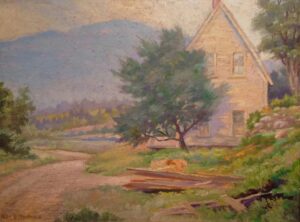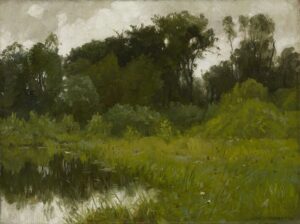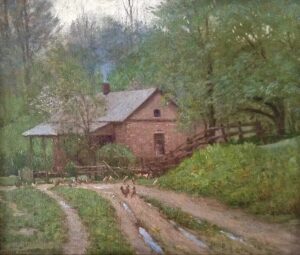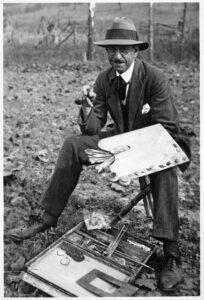Small Home Gazette, Winter 2023
Twin Cities Plein Air Artist Alexis Fournier
A Profile
The following is adapted from an article by R.L. Cartwright, “Fournier, Alexis Jean (1865–1948).” MNopedia, Minnesota Historical Society.
www.mnopedia.org/person/fournier-alexis-jean-1865-1948 (accessed December 30, 2022).
Born in St. Paul, Minnesota, on July 4, 1865, Alexis Jean Fournier was raised in Wisconsin by French Canadian parents. In 1879, at the age of 14, Fournier moved to Minneapolis. Aspiring to be an artist, Fournier found work painting signs and stage scenery. Creating stage scenery gave him more time for his own painting and gave him experience painting panoramas, a popular 19th century art form.

Summer House, by Alexis Jean Fournier.
In 1886, Fournier attended a class at the newly established Minneapolis School of Art. The school was directed by Boston artist Douglas Volk, and Fournier soon took private lessons with him. Under Volk’s instruction, Fournier developed a more subtle sense of color and a brushier style.
During the next three years, Fournier married his first wife Emma and had two children, Grace and Paul. He also began supporting his family as a full-time artist.
Fournier was invited to travel around the American Southwest with patron H. Jay Smith in 1891. After the trip, Fournier painted an acclaimed 50-by-12-foot panoramic mural that depicted stone dwellings in cliffs in the Mesa Verde region of Colorado constructed by Ancient Puebloans. The panoramic was displayed at the 1893 Columbian Exposition in Chicago, where thousands of people saw the mural and heard Fournier interpret it publicly.
Continuing to grow as an artist, in 1893, Fournier traveled to Paris, France, where he studied at the Académie Julian. His trip was funded by several benefactors, including James J. Hill. In France, Fournier was strongly influenced by the Barbizon school, a group of 19th century French painters who were drawn to natural landscapes and romanticism.

After Rain, on Minnehaha Creek, by Alexis Jean Fournier. This painting is part of the Minneapolis Institute of Art (Mia) collection.
Between 1895 and 1901, Fournier made several more trips to Paris. In between, he returned to Minneapolis and continued painting Twin Cities landmarks. He also became associated with the Arts & Crafts movement, an arts revival emphasizing handmade crafts. Arts & Crafts movement leader John Scott Bradstreet invited Fournier to paint murals in Twin Cities dining rooms that he was commissioned to decorate.
Fournier’s connection to the Arts & Crafts movement deepened in 1903 when he moved to East Aurora, New York, home of the Roycroft arts community. The community’s leader, Elbert G. Hubbard, had been friends with Fournier for several years. Fournier’s move to East Aurora came after Hubbard invited him to be the Roycroft community’s permanent art director.
Hubbard was a flamboyant man, and he traveled around the country giving lectures. Fournier, known for his charming personality and good humor, went with Hubbard on many of these trips. Fournier kept Hubbard company and exhibited his paintings at the lectures, bringing his work to a broader audience.
The Roycroft community changed in 1915 when Hubbard and his wife died aboard the Lusitania, an ocean liner that was famously torpedoed by Germans during World War I. After his friend’s passing, Fournier became close to a group of regional painters in Brown County, Indiana. He influenced their style, but they also influenced his. His paintings from Indiana were brighter and more impressionistic than his earlier work.

The Little Stone House, by Alexis Jean Fournier.
Fournier’s first wife died, and he sold his home in Minneapolis in 1921. He moved to Indiana the next year, when he married a widow whose husband had been linked to the Brown County artists. He continued to spend summers in East Aurora. After the death of his second wife in 1937, he moved to East Aurora permanently, and in 1941, he married a third time.
In 1948, at the age of 82, Fournier slipped on an icy sidewalk and sustained injuries resulting in his death. Through his landscape paintings and his role in the Arts & Crafts movement, Fournier made a lasting influence on American art. His obituaries revered him as “the last of the Barbizon painters,” since his style and admiration for the natural world brought the Barbizon tradition well into the 20th century. His paintings were exhibited around the world during his lifetime and continue to be displayed and collected.









 Alexis Fournier was an internationally respected Minneapolis artist during the Arts & Crafts era who used plein air techniques throughout his long career. A colleague of John Bradstreet and Elbert Hubbard, Fournier helped articulate the artistry in everyday life that early bungalow owners sought for their homes.
Alexis Fournier was an internationally respected Minneapolis artist during the Arts & Crafts era who used plein air techniques throughout his long career. A colleague of John Bradstreet and Elbert Hubbard, Fournier helped articulate the artistry in everyday life that early bungalow owners sought for their homes.

